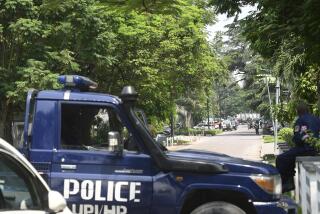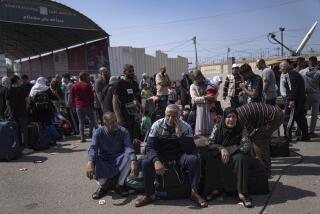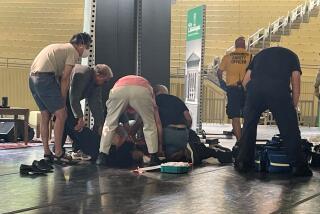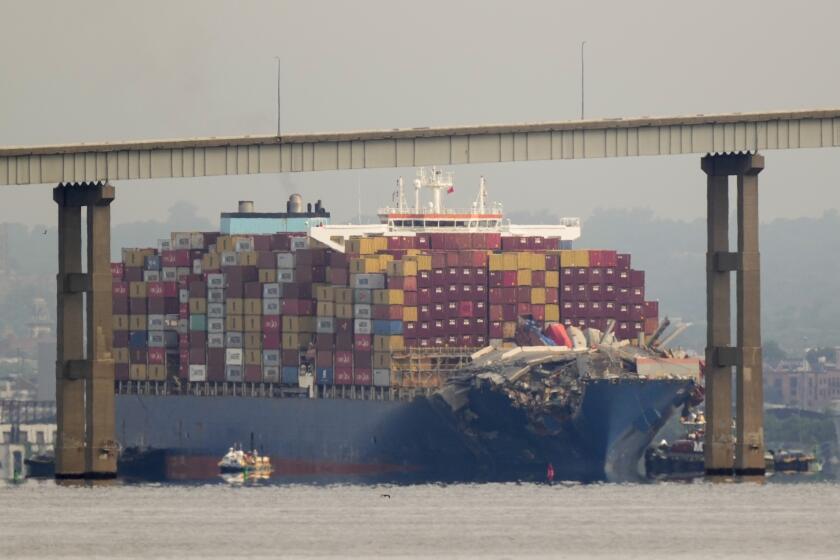A DREADED STOP
A DREADED STOP
Each time the train slows, Enrique goes on high alert for la migra.
 Immigrants wake one another and begin climbing down to prepare to jump. If the train speeds up again, everyone climbs back up. The movement down and up the ladders looks like a strangely choreographed two-step.
Immigrants wake one another and begin climbing down to prepare to jump. If the train speeds up again, everyone climbs back up. The movement down and up the ladders looks like a strangely choreographed two-step.
But slowing down at Huixtla, with its red and yellow depot, can mean only one thing: Coming up is La Arrocera, one of the most dreaded immigration checkpoints in Mexico.
Enrique has defied La Arrocera before. This time, he arrives in the heat of noon. Tension builds. Some migrants stand on top of the train, straining to see the migra agents up ahead. As the train brakes, they jump.
The train lurches sideways. Enrique leaps from car to car, finally landing on a boxcar. The train stops.  He lies flat, face down, arms spread-eagle, hoping la migra won’t see him. But several agents do.
He lies flat, face down, arms spread-eagle, hoping la migra won’t see him. But several agents do.
“¡Bajate, puto! Get down, you whore!”
“No! I’m not coming down!”
There is no ladder all the way to the top. Maybe they won’t come up after him.
“Get down!”
“No!”
The agents summon reinforcements. One starts to climb up.
Enrique scrambles to his feet and races along the top of the train, soaring across the 4-foot gaps between cars. As he runs, three agents follow on the ground, pelting him with rocks and sticks, an experience many immigrants say they have here. Stones clang against the metal. Enrique flees from car to car, more than 20 in all, struggling to keep his footing each time he leaps from a hopper to a fuel tanker, which is lower and has a rounded top.
He is running out of train. He will have to go around La Arrocera alone. It may be suicidal, but he has no choice. More stones ping off the train. Enrique scurries down a ladder and sprints into the bushes.
 “¡Alto! ¡Alto! Stop!” the agents shout.
“¡Alto! ¡Alto! Stop!” the agents shout.
As Enrique runs, he hears what he thinks are gunshots behind him.
Except in extraordinary circumstances, Mexican immigration agents are barred from carrying firearms. According to a retired agent, however, most have .38-caliber pistols. Some of the shelter workers tell of migrants hit by bullets. Others tell of torture. Before long, Enrique will meet a man whose chest is pockmarked with cigarette burns. The man tells him that a migra agent at La Arrocera branded him.
In the scrub brush, though, Enrique worries less about agents than about madrinas with machetes. The name for these men is a play on words: These civilians help the authorities, as a madrina, or godmother, would, and administer madrizas, or savage beatings. Human rights activists and some police agencies say the madrinas commit some of the worst atrocities--rapes and torture--and are allowed by authorities to keep a portion of what they steal.
Enrique runs on. He crawls under a barbed wire fence, then under a double strand of smooth wire. It is electrified. At night, Guillermina Galvez Lopez, who lives at La Arrocera, hears the trains and, not long afterward, the piercing screams of immigrants, wet from the swampy grass, who run into the wire.
“Help me! Help me!” they wail.
Ten times in 10 months, train riders have carried to her front door men and boys without arms, legs or heads. In 1999, Clemente Delporte Gomez, a patrolman with Grupo Beta Sur, the government’s migrant rights organization, watched a young Salvadoran slip on railroad ties near La Arrocera. Train wheels cut him in two at the midriff. Delporte saw the Salvadoran’s heart flicker three times. Then it was still.
 Enrique knows he has plunged deep into bandit territory. At least three, maybe five swarms of robbers, some with Uzis, some on drugs, patrol the three-mile dirt paths that immigrants must use to go around La Arrocera, authorities say. They seem to operate with such impunity that Mario Campos Gutierrez, a supervisor with Grupo Beta, thinks the authorities collaborate.
Enrique knows he has plunged deep into bandit territory. At least three, maybe five swarms of robbers, some with Uzis, some on drugs, patrol the three-mile dirt paths that immigrants must use to go around La Arrocera, authorities say. They seem to operate with such impunity that Mario Campos Gutierrez, a supervisor with Grupo Beta, thinks the authorities collaborate.
Before taking these paths, migrants hide their money. Some stitch it into the seams of their pants. Others put a bit in their shoes, a bit in their shirts and a coin or two in their mouths. Still others bag it in plastic and tuck it into intimate places. Some roll it up and slip it into their walking sticks. Others hollow out mangoes, drop their pesos inside, then pretend to be eating the fruit.
Enrique figures he doesn’t have enough money to bother.
Last time he sneaked past La Arrocera, he was lucky because he was careful. He stuck with a band of street gangsters. This time he is alone. He focuses on the thought that will make him run the fastest: “I cannot miss the train.”
If he misses the one he just left, he knows he will be a sitting duck, waiting for days in the bushes and the tall grass until another one comes.
Enrique races so fast he feels the blood pounding at his temples. The grass, growing in three-foot tentacles, lassos his feet. He stumbles, gets up and keeps running. He passes an abandoned brick house. Half the roof is gone.
The house is notorious. Not long before, Grupo Beta had found a bed of bricks inside, covered with emerald green leaves from a plant that looked like a bird of paradise--and two soiled pairs of panties crumpled on the dirt floor. Women are raped here, most recently a 16-year-old assaulted repeatedly over three days.
Many are gang-raped, including a Salvadoran woman, four months pregnant, who was assaulted at gunpoint by 13 bandits along the railroad tracks to the south. Nearly one in six immigrant girls detained by authorities in Texas says she has been sexually assaulted during her journey, according to a 1997 University of Houston study. Some girls journeying north cut off their hair, strap their breasts and try to pass for boys. Others scrawl on their chests: “TENGO SIDA. I have AIDS.”
Enrique does not stop. He reaches the Cuil bridge, where the railroad spans a 40-foot stream of murky brown water. This, migrants and Grupo Beta officers say, is the most dangerous spot. Bandits haul mattresses up into nearby trees, eat lunch and wait for their prey. As immigrants cross the bridge, the bandits drop out of the limbs and surround them. Other robbers hide along the tracks above and below the bridge, which is thick with bushes and vines. One fishes in the river or cuts grass with a machete, like a fieldworker, and whistles to the others to set a trap.
Just a month before, bandits ambushed five Salvadorans as they crossed the bridge at 4 a.m. They tried to run. The bandits shot one in the back. Four months later, three Salvadorans and a Mexican, all in their 20s, were killed. The Salvadorans, their hands tied behind them, were shot in the head. The Mexican was stabbed. All they had left was their underwear.
Enrique dashes across the bridge and keeps running. Mountains stand to his right. The ground is so wet that farmers grow rice between their rows of corn. He can feel heat and humidity rising from the loamy earth. It saps his energy, but he runs on.
Finally, he stops, doubled over, panting.
He is not sure why, but he has survived La Arrocera. Maybe it was his extra caution, maybe it was his decision to run, maybe it was his attempt to lie flat and hide atop the boxcar, which delayed his getting off the train and gave the bandits an opportunity to target migrants ahead of him.
He is desperate for water. He spots a house.
The people inside are not likely to give him any. Chiapas is fed up with Central American immigrants, says Hugo Angeles Cruz, a professor and migration expert at El Colegio de la Frontera Sur in Tapachula. They are poorer than Mexicans, and they are seen as backward and ignorant. People think they bring disease, prostitution and crime and take away jobs. Some cannot be trusted. People in Chiapas talk of being robbed by migrants with guns and knives. They tell of an older woman who welcomed an immigrant into her home and was beaten to death with an iron pipe.
Boys like Enrique are called “stinking undocumented.” They are cursed, taunted. Dogs are set upon them. Barefoot children throw rocks at them. Some use slingshots. “Go to work.” “Get out! Get out!”
 Drinking water can be impossible to come by. Migrants filter ditch sewage through T-shirts. Finding food can be just as difficult. Enrique is counting: In some places, people at seven of every 10 houses turn him away.
Drinking water can be impossible to come by. Migrants filter ditch sewage through T-shirts. Finding food can be just as difficult. Enrique is counting: In some places, people at seven of every 10 houses turn him away.
“No,” they say. “We haven’t cooked today. We don’t have any tortillas. Try somewhere else.”
“No, boy, we don’t have anything here.”
Sometimes it is worse. People in the houses turn the immigrants in.
Enrique sees another migrant who has managed to make it around La Arrocera. He, too, needs water badly, but he doesn’t dare ask. He is afraid of walking into a trap. To immigrants, begging in Chiapas is like walking up to a loaded gun.
“I’ll go,” Enrique says. “If they catch someone, it will be me.”
He approaches a house and speaks softly, his head slightly bowed. “I’m hungry. Can you spare a taco? Some water?” The woman inside sees injuries from the train-top beating he took during his last attempt to go north. “What happened?” she asks. She gives him water, bread and beans.
The other migrant comes nearer. She gives him food too.
A horn blows. Enrique runs to the tracks. Other immigrants who have survived La Arrocera come out of the bushes. They sprint alongside the train and reach for the ladders on the freight cars.
Enrique climbs up onto a hopper. The train picks up speed.
For the moment, he relaxes.
| [ Return to Top ] | NEXT: STAYING AWAKE |
More to Read
Start your day right
Sign up for Essential California for news, features and recommendations from the L.A. Times and beyond in your inbox six days a week.
You may occasionally receive promotional content from the Los Angeles Times.






